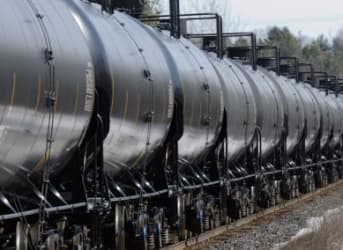Weekly oil shipments by rail can be found on the web at Weekly Carload Reports. And a summation of that data with charts can be found at Association of American Railroads Freight Rail Traffic Data.
(Click to enlarge)
Crude oil by rail basically started with the shale boom. Prior to that almost all oil was shipped by pipeline. Of course a lot of oil was trucked to the pipelines. The EIA says in the first seven months of 2014, 8 percent of all U.S crude and refined products was shipped by rail. It looks like that percentage was increased somewhat in the second half of 2014.
(Click to enlarge)
Oil by rail, for the entire USA, peaked in August, September and October of 2014 and has declined since. Related: Can This Next Shale Hotspot Live Up To The Hype?
(Click to enlarge)
I have converted the weekly carloads to daily then converted carloads to barrels. There are about 700 barrels per carload. That gives us the average barrels per day by rail.
(Click to enlarge)
I have converted the weekly “daily average” to monthly “daily average” and plotted it against the North Dakota production. The EIA says: Between 60% and 70% of the more than 1 million barrels per day of oil produced in the state has been transported to refineries by rail each month in the first half of 2014, according to the North Dakota Pipeline Authority. Related: Can This Next Shale Hotspot Live Up To The Hype?
(Click to enlarge)
As we can see from this chart the volume of oil shipped by rail changes from month to month. The chart is barrels per day per month. The peak, for North Dakota, is December 2014. Oil by rail for the USA peaked about three months earlier.

Also the percentage of oil shipped by rail drops as production drop. This is because the pipelines are usually at max capacity so as production drops rail traffic takes the blunt of the decline.
The following is Art Berman’s take on the matter.
I have resolved the crude oil movement by rail issue that arose yesterday by comparing American Association of Railroads (AAR) data with EIA data. Related: More Job Losses Coming to U.S. Shale
Here is the AAR data:
(Click to enlarge)
Here are the problems.
1) The AAR data is for Petroleum & Petroleum Products whereas EIA data is for crude oil.
2) The AAR data goes through June whereas EIA data only includes April.
3) AAR data is in carloads or international units (whatever international units is) whereas EIA data is in barrels.
All that notwithstanding, the AAR data appears to be essentially correct in that it shows that 2015 rail shipments have probably dipped below 2013 levels assuming that the EIA data for May and June follow the AAR trend. That appears to be price-related as far as I can tell.
The EIA data allows me to exclude the possibility that the decrease in shipments is because of Canadian bitumen. It is down also but does not account for the magnitude of decrease.
The EIA divides oil movement by rail into PADD. 70% of total oil moved is from the Bakken and Colorado & Canada each have about 13%, with most of the small remainder (4%) from California.
In April, 96 kbpd less oil was moved by rail than in December (131 kbpd in February). April Bakken production was 59 kbpd less than December (February was 50 kbpd less), so it seems more than reasonable that the difference is being taken by the new 84 kbpd pipeline.
I think that the problem is solved.
By Ron Patterson
More Top Reads From Oilprice.com:
- Can U.S. Nuclear Plants Operate For 80 Years?
- Obama’s Goals For Middle East Hinge On Putin
- This Week In Energy: Oil Shows No Signs Of A Rebound Amid Ongoing Slump

























As a point of interest, the comment attributed to Art Berman may have an error. He suggests that 13% of crude by rail is Canadian. However, the AAR provide completely separate figures for Canadian rail transport.
Petroleum and petroleum products moved by rail are now (July week 1) down 20% from the average for Q4 2014. Compared to December 2014 Bakken production of 1.227 MM bopd, this implies a reduction of 247,000 bopd. Even if 84,000 can be accounted for by new pipeline infrastructure, this still implies that Bakken July week 1 production is down by 163,000 bopd. That is 13.3%.
Given that the rig count reductions for the other main basins are similar to those in the Bakken (65%), Eagle Ford (63%), Permian (57%), and applying a reduction of 13%, and assuming total unconventional oil production of 4,5 MM bopd in December 2014, July unconventional production is down 598,000 bopd.
The EIA issues three different reports on US production and the numbers they give are different in all three. In the only one in which they suggest consistent drops since April (their Drilling productivity reports), the EIA's total reduction in production (including their prediction for August) is 332,000 bopd. Meanwhile this simple calculation suggests a number nearly twice as large.
That seems more reasonable than the other figures issued by the EIA claiming still-rising US production, in the teeth of a rig count reduction of 60%.